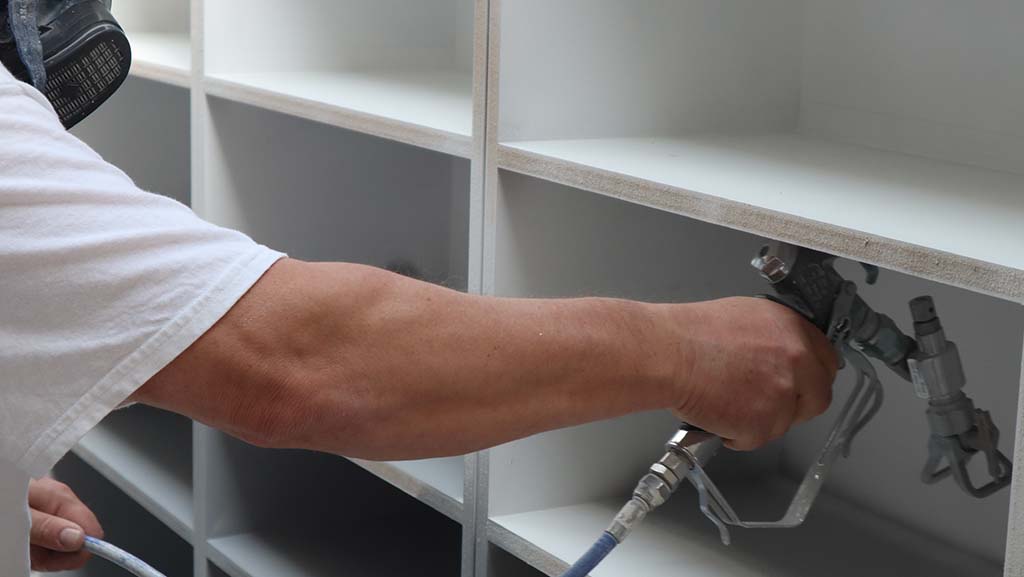These days it seems that everyone is having their kitchen sprayed.
What is the reason for this?
Well, it’s simple, if you have a dated kitchen that is still in great condition then you can have it sprayed so that it looks brand new and it is the fraction of the cost of a new kitchen and there is much less disruption too. You don’t have to have your kitchen ripped out and, in many cases, you are only without the kitchen for a couple of days.
After spending a couple of hours on Instagram you look at your kitchen and decide that it’s looking a little tired and also mahogany is so last century. “It needs spraying” you think to yourself. In a flash, you go online and find a kitchen spraying specialist. The before and after pictures look great! You ask them to come and give you a quote.
Before they come you decide to price up a new kitchen as a comparison. To have a new kitchen supplied and fitted you are quoted £10,000. This is roughly what you expected.
The kitchen sprayer arrives with his notepad and sample panels. You look at the sprayed sample panels and they look amazing. He invites you to “scratch test” one so that you can see how durable the new coating will be. The finish is amazing too. He leaves you with a sample and tells you that the quote will be with you in a couple of days.
Download Now: The Ultimate Guide To Spraying [Free Template]
You are so excited.
A couple of days pass and your phone rings. “The price to spray the kitchen will be £1500, just let us know when you would like us to start” they say.
£1500 is not what you were expecting. It is much less than a new kitchen and in fairness, it would look amazing. You wonder how much work is involved and you wonder if you could do it yourself.
In this blog, we will discuss the steps that you would need to go through to spray your kitchen.
10 Steps to spray your kitchen
We will discuss the steps that you would need to go through to spray your kitchen.
Step 1
You need to remove the doors and drawer fronts. Make sure that you label everything up because at the end of the process you are going to have to put them all back in their original place.
Step 2
Degrease all the surfaces with a degreaser. There is a number on the market, most decorators would use sugar soap. This is important because a kitchen is a greasy place and paint will not stick to any surface that has the slightest trace of grease on it. It’s quite time-consuming and it must be done right.
Step 3
Sand all the surfaces to make sure that they are smooth and that you have a key for the paint to stick to. You are best using a dustless sander. This is so that you get a nice smooth surface, and you eliminate dust from the sanding process.
Step 4
Apply a primer to the surface using a sprayer. We have discussed different sprayers in another blog What is the best sprayer for cabinets check it out. You need to use an adhesion primer so that it sticks to the surface properly and we also prefer to use water-based systems for health and safety reasons.
Step 5
Stain block.
You may not need to do this. It depends on what type of kitchen that you have. If it is bare wood or stained, then you will probably get some stains bleeding through the primer. These need to be blocked. There are many stain blockers out there, Zinsser BIN does a meths-based product that comes in an aerosol can so that it’s easy to spray onto stains.
Step 6
Fill and caulk all the doors and panels. It is very likely that if the doors have never been painted they will need quite a bit of filling because once they are painted any cracks or defects will show. This can be a time-consuming process and this needs to be done well otherwise the filling will show on the finished paint.
Step 7
Abrade the surface again, use a 240-grade paper so that you do not rub through the stain blocker.
Step 8
Decide what paint you are going to use for the final coats. There are a few out there on the market. A company called “Renner” makes a water-based finish paint designed for cabinet spraying. Apply the final coats of paint, you will need at least 2 coats, abrade between coats to get the best finish possible.
Step 9
It is very unlikely that you will spray inside the kitchen cupboards, these need to be masked off so that when you spray the edges of the kitchen and the plinth, etc you do not get any paint in the cupboards. Once you have masked off the cupboards you need to spray everything that you have not removed using the exact same process as the doors and drawer fronts.
Step 10
Now that everything is sprayed you need to replace everything that you have removed, carefully.
You can see from this 10 step process that there is quite a lot involved in spraying cabinets and if you do have a go and do it yourself then by the end of the work the original quote of £1500 may seem fair after all.





